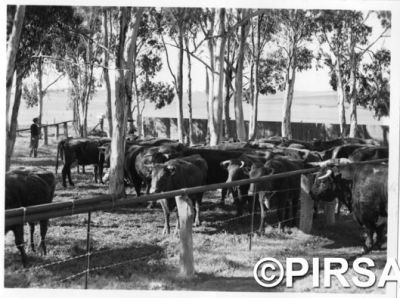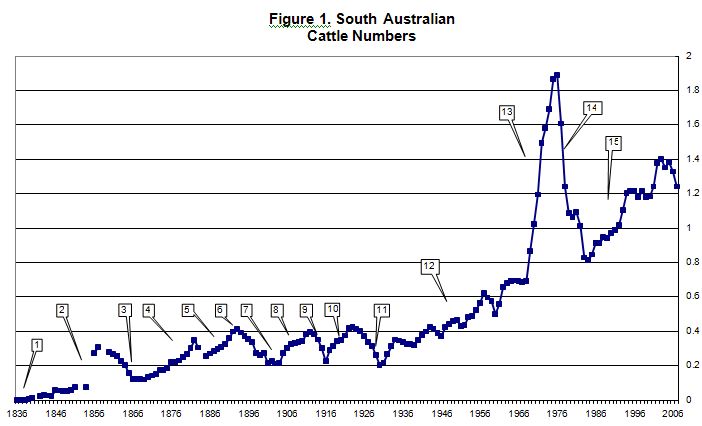Herd Expansion & Distribution
Prior to the arrival of Governor Hindmarsh on the Buffalo and his associated ships it is likely the only cattle, in South Australia were some that whalers had brought with them but there is no evidence that this occurred.
At the time of the Proclamation of South Australia in December 1836 there seems little reference to cattle although one reference says one dairy cow owned by Governor Hindmarsh was on the Buffalo. (Brown William Voules, State Library of SA) (Pastoral Pioneers of South Australia vol 1, Publishers Limited, p.45, 1925) Gibbs reports that the John Pirie unloaded some cows and that some more stock were soon brought over from Tasmania. (Gibbs RM, A History of South Australia, Peacock Publications, Kent Town, SA, 1969) By the end of 1838 the cattle population had increased to 2,500 cattle, 480 horses, 28,000 sheep, and 6,000 people. George Fife Angas(Pastoral Pioneers of South Australia vol 1, p9, Publishers Limited, Adelaide, 1925) was instrumental in ensuring the colony had livestock when it was founded, with the South Australian Company owning the most stock. By 1838 the human population had received insufficient stores to maintain the growing migrant and natural increase in population. Kangaroo flesh was fetching one shilling per pound.(Pastoral Pioneers of South Australia vol 1, p13, Publishers Limited, Adelaide, 1925) Consequently feeding the population posed a major challenge. In January 1838, Joseph Hawdon from Sydney, overlanded from the River Hume in northern Victoria, 335 head of cattle arriving completely unexpectedly in Adelaide on April 3 1838 and subsequently selling the stock at a handsome profit.(Pastoral Pioneers of South Australia vol 1, p12, Publishers Limited, Adelaide, 1925) This was followed by a number of “overlands” of sheep and cattle, providing food for the colony and the breeding basis for the State’s flocks and herds.(Maurovic Richard, The Meat Game, p2, Wakefield Press, Kent Town, SA 2007) Further information on droving and on the development of stock routes is provided in Leith Yelland’s book “Pads, tracks and waters”. (Yelland Leith, Pads tracks and waters, Govt. of South Australia, 2002).
As the colony developed, cattle were vital for the provision of dairy products (milk, cheese, butter), beef, tallow (for oil and candles) and transport (bullock teams).
By 1841 the cattle population exceeded the human population but immigration continued, as did overlanding of cattle. Supply and demand generally kept in balance over the next few years. It is noted in the 1884 Statistical Registrar, South Australia (Statistical Registrar of SA 1884) exported less than 30 tons of meat but 1,100 tons of tallow. Beef was locally consumed as it could not be stored/preserved for transport other than by salting or later canning.
Explorers discovered new lands to the north of the State and squatters rapidly followed with sheep and cattle. In 1876 William Harcus reports that of South Australia’s 383,000 square miles it may be estimated “250,000 square miles are put to profitable use” with pastoral occupation extending 500 miles inland.(Harcus William, Handbook for emigrants proceeding to Adelaide, SA, G Street, London, 1873) At this time less than 2,000 square miles were under tillage. The total area of land held for pastoral purposes beyond the boundaries of the Counties is estimated to be 188,000 square miles. This had grown from 15,000 square miles leased from the crown in 1851. During this period the number of horses increased from 6,500 to 93,000; of horned cattle from 75,000 to 185,000; and of sheep from 1,000,000 to 6,000,000. Harcus states “with reference to the slight comparative increase in cattle it should be noted that more profitable results are found to accrue from the breeding of sheep than from great cattle. The latter pursuit is more extensively followed in the neighbouring colonies. During the last ten years the average price of first-class fat bullocks has averaged £14 10s, and of first-class fat wethers, 15s per head”. Fencing of runs was under way, reducing the need for shepherds and opening vast areas for both sheep and cattle. Almost limitless tracts of country bordering on the trans-continental telegraph line, as well as land laid open by recent explorations, are waiting pastoral occupation.”
By 1868 Pastoral Pioneers of SA records both P Waite and HB Hughes using fencing to replace shepherds.(Pastoral Pioneers of South Australia Vol 1, Publishers Limited, P45, 1925) In 1870 and 1871 Waite imported from England 265 tons of wire for fencing and making paddocks. (Pastoral Pioneers of South Australia vol 1, Publishers Limited, p75, 1925) This was a critical turning point in the management of sheep and cattle in the large scale operations in South Australia. Mr Hughes had been similarly innovative when in the 1864–6 drought he established a canning plant at Booyoolee Station(Pastoral Pioneers of South Australia vol 1, Publishers Limited, p45, 1925), Gladstone, to avoid the glut of sheep in the market. He brought men from Scotland to run the plant and after the drought sold the plant to Dean and Laughton (stock agents) who re-erected it at Port Adelaide.
All pastoral leases were held with the condition that whenever the land was required for agricultural purposes, the squatter must leave on receiving six months’ notice, the lessee being paid for substantial improvements made on his run. Throughout this period the farmed land was continuously cropped with few if any (other than draft) animals being run by crop farmers.
At one point the Pastoral Board indicated that 15 stations (sheep and/or cattle) had no permanent carrying capacity. (Love John, Determined to improve the land: a history of the Department of Agriculture, The History of Agriculture in SA website, 1987) Financiers demanding repayment of loans and insisting on restocking too soon after drought caused some overstocking. Between the great depression and the poor season in 1929–30 cattle and dairy numbers declined by more than half of that in the previous seven years (see Figure 1). In the initial stages cattle were run on large estates or pastoral runs from Mt Gambier in the south to the ever expanding northern zone of the state. Scanning the biographical summaries in Pastoral Pioneers of South Australia(Pastoral Pioneers of South Australia vol 1 and 2, Publishers Limited, Adelaide, 1925) gives a detailed insight of the scale and approach taken prior to the 1940s. Many of these properties were later subdivided into smaller properties (including Soldier Settler blocks) running predominantly sheep, or converted to mixed cereal farming. Extensive land development and improved pastures expanded the carrying capacity of the South East of the State in the 1950s and 60s, leading to increased numbers with the result that today about 50% of the cattle are run in the higher rainfall country, 25% in the cereal belt and 25% in the northern pastoral area.

Beef cattle in the 1950s
Expansion had seen South Australia’s cattle herd grow from 170,000 in the 1940s to 260,000 in 1960 to 800,000 in 1970, with a peak of 1,890,000 in 1976. (Various Government Statistical Registrars and Livestock Statistical publications) (Statistical Handbook of the Australian Meat Industry plus various MLA publications) It then collapsed to 1,000,000 in 1980 before sinking to 980,000 in the 1987 drought and then slowly increasing again as different markets emerged to today’s population of 1,300,000. In the 1950s the prime market was the UK absorbing approximately 90% of total beef exports. By 1970 production was rapidly expanding and North America was taking 80% of national production. In the early 1970s the Japanese market opened up providing additional competition.
The American “hamburger market” based on boned out frozen lean beef collapsed in the late 70s at a time when the breeding time lag resulted in large numbers of cattle reaching the market, and then seasonal conditions deteriorated. Following this it was a slow recovery. Building new quality markets in Asia, ability to export chilled beef, the development of the feedlot industry and live cattle exports from northern Australia to Asia resulted in a balanced local consumption and export oriented beef industry.
Today technical innovation continues, with the ability to trace beef from production to consumption providing both quality and health status feedback to customers in Australia or across the world.
Effects on SA cattle herd
Drought had the most severe effect on the State’s cattle herd particularly in the pastoral areas during the early years. Cattle numbers would build up in a series of above average years and wipe out fortunes in a single season. An example would be the 1864–65 drought as can be seen in the graph below when the State’s cattle herd halved. Gibbs reports that the area beyond Mount Serle carried 30,000 cattle in 1864 but it fell to 7,761 by the end of 1866. (Gibbs RM, A History of South Australia, Peacock Publications, Kent Town, SA, (1969))
The following graph traces the state’s cattle herd from Proclamation to current times. It demonstrates the effects of seasons, disease and available markets on the herd.

- In 1837 cattle were first overlanded to fill meat shortage in SA and then followed by other droves from Victoria and NSW. Demand for bullocks for draft and meat increased as population expanded away from Adelaide. A drought in 1854 held the numbers down.
- From 1855 to 1857 the cattle population expanded with a series of above average seasons. However with no substantial markets for beef, growth faltered when supply exceeded demand.
- 1859 and 1860 were below average years and they took their toll on cattle numbers but with pleuro pneumonia hitting the herd (1863) and rabbits decimating pastures numbers collapsed, and with the 1864–69 drought numbers were at bedrock. By the1870s boiling down works were established to dispose of the surplus cattle. Goyder’s Line established.
- HB Hughes established a canning plant at Booyoolee in 1864. In the decade 1869–79 the Australian meat preserving industry exported some 65,000 tons of preserved meats to England. This trade was stimulated by the demand for meat resulting from the shortage induced by cattle plague in England, and was aided by the Franco-Prussian War of 1870–1 plus the virtual lack of competition from the Americas until late in the decade. Pleuro inoculation became available. Wire and post fencing replaced shepherds improving management efficiency.
- 1881 began a series of below average seasons resulting in a fall in numbers again.
- 1885 to 1892 a series of above average years and numbers again built up.
- 1890s: average to below average rainfall years; 1895 freezing works established at Port Adelaide.
- Good seasons and refrigeration adopted and frozen meat trade expanded. 1907 – export abattoir established at Port Adelaide.
- 1914 drought and World War Two labour effects.
- 1916–23 extremely good seasons and numbers expand.
- Poorer seasons and rabbit numbers effects on pasture resulting in cattle numbers declining. Great Depression depresses cattle demand.
- 1930: cattle retained during depression then a series of seasons where below average rains only last one year; Myxomatosis effective against rabbits, Pasture improvement and expansion in the South East.
- Cattle numbers boom due to depressed wool prices and great demand for beef from North America.
- American market collapses, State “overstocked” and two years of drought in 1976–77 result in a crash in cattle numbers and a further decline in the 1982–83 drought, probably to below sustainable levels.
- Gradual increase in numbers, (calici virus effects on rabbits) with dips as seasons vary, markets change and wool prices deteriorate.
